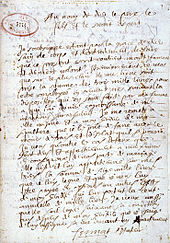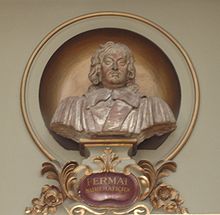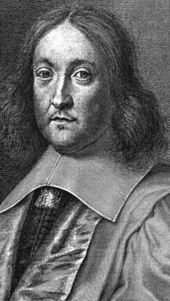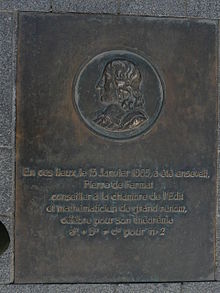- Pierre de Fermat
-
Pierre de Fermat 
Pierre de FermatBorn August 17, 1601
Beaumont-de-Lomagne, FranceDied January 12, 1665 (aged 63)
Castres, FranceResidence France Nationality French Fields Mathematics and Law Known for Number theory
Analytic geometry
Fermat's principle
Probability
Fermat's Last TheoremInfluences François Viète Pierre de Fermat (French pronunciation: [pjɛːʁ dəfɛʁˈma]; 17[1] August 1601 or 1607/8[2] – 12 January 1665) was a French lawyer at the Parlement of Toulouse, France, and an amateur mathematician who is given credit for early developments that led to infinitesimal calculus, including his adequality. In particular, he is recognized for his discovery of an original method of finding the greatest and the smallest ordinates of curved lines, which is analogous to that of the then unknown differential calculus, and his research into number theory. He made notable contributions to analytic geometry, probability, and optics. He is best known for Fermat's Last Theorem, which he described in a note at the margin of a copy of Diophantus' Arithmetica.
Contents
Life and work
Fermat was born in Beaumont-de-Lomagne, Tarn-et-Garonne, France; the late 15th century mansion where Fermat was born is now a museum. He was of Basque origin. Fermat's father was a wealthy leather merchant and second consul of Beaumont-de-Lomagne. Pierre had a brother and two sisters and was almost certainly brought up in the town of his birth. There is little evidence concerning his school education, but it may have been at the local Franciscan monastery.
He attended the University of Toulouse before moving to Bordeaux in the second half of the 1620s. In Bordeaux he began his first serious mathematical researches and in 1629 he gave a copy of his restoration of Apollonius's De Locis Planis to one of the mathematicians there. Certainly in Bordeaux he was in contact with Beaugrand and during this time he produced important work on maxima and minima which he gave to Étienne d'Espagnet who clearly shared mathematical interests with Fermat. There he became much influenced by the work of François Viète.
From Bordeaux, Fermat went to Orléans where he studied law at the University. He received a degree in civil law before, in 1631, receiving the title of councillor at the High Court of Judicature in Toulouse, which he held for the rest of his life. Due to the office he now held he became entitled to change his name from Pierre Fermat to Pierre de Fermat. Fluent in Latin, Basque[citation needed], classical Greek, Italian, and Spanish, Fermat was praised for his written verse in several languages, and his advice was eagerly sought regarding the emendation of Greek texts.
He communicated most of his work in letters to friends, often with little or no proof of his theorems. This allowed him to preserve his status as an "amateur" while gaining the recognition he desired. This naturally led to priority disputes with contemporaries such as Descartes and Wallis. He developed a close relationship with Blaise Pascal.[3]
Anders Hald writes that, "The basis of Fermat's mathematics was the classical Greek treatises combined with Vieta's new algebraic methods."[4]
Work
Fermat's pioneering work in analytic geometry was circulated in manuscript form in 1636, predating the publication of Descartes' famous La géométrie. This manuscript was published posthumously in 1679 in "Varia opera mathematica", as Ad Locos Planos et Solidos Isagoge, ("Introduction to Plane and Solid Loci").[5]
In Methodus ad disquirendam maximam et minima and in De tangentibus linearum curvarum, Fermat developed a method for determining maxima, minima, and tangents to various curves that was equivalent to differentiation.[6] In these works, Fermat obtained a technique for finding the centers of gravity of various plane and solid figures, which led to his further work in quadrature.
Fermat was the first person known to have evaluated the integral of general power functions. Using an ingenious trick, he was able to reduce this evaluation to the sum of geometric series.[7] The resulting formula was helpful to Newton, and then Leibniz, when they independently developed the fundamental theorem of calculus.[citation needed]
In number theory, Fermat studied Pell's equation, perfect numbers, amicable numbers and what would later become Fermat numbers. It was while researching perfect numbers that he discovered the little theorem. He invented a factorization method—Fermat's factorization method—as well as the proof technique of infinite descent, which he used to prove Fermat's Last Theorem for the case n = 4. Fermat developed the two-square theorem, and the polygonal number theorem, which states that each number is a sum of three triangular numbers, four square numbers, five pentagonal numbers, and so on.
Although Fermat claimed to have proved all his arithmetic theorems, few records of his proofs have survived. Many mathematicians, including Gauss, doubted several of his claims, especially given the difficulty of some of the problems and the limited mathematical tools available to Fermat. His famous Last Theorem was first discovered by his son in the margin on his father's copy of an edition of Diophantus, and included the statement that the margin was too small to include the proof. He had not bothered to inform even Marin Mersenne of it. It was not proved until 1994, using techniques unavailable to Fermat.
Although he carefully studied, and drew inspiration from Diophantus, Fermat began a different tradition. Diophantus was content to find a single solution to his equations, even if it were an undesired fractional one. Fermat was interested only in integer solutions to his Diophantine equations, and he looked for all possible general solutions. He often proved that certain equations had no solution, which usually baffled his contemporaries.
Through his correspondence with Pascal in 1654, Fermat and Pascal helped lay the fundamental groundwork for the theory of probability. From this brief but productive collaboration on the problem of points, they are now regarded as joint founders of probability theory.[8] Fermat is credited with carrying out the first ever rigorous probability calculation. In it, he was asked by a professional gambler why if he bet on rolling at least one six in four throws of a die he won in the long term, whereas betting on throwing at least one double-six in 24 throws of two dice resulted in him losing. Fermat subsequently proved why this was the case mathematically.[9]
Fermat's principle of least time (which he used to derive Snell's law in 1657) was the first variational principle[10] enunciated in physics since Hero of Alexandria described a principle of least distance in the first century CE. In this way, Fermat is recognized as a key figure in the historical development of the fundamental principle of least action in physics. The terms Fermat's principle and Fermat functional were named in recognition of this role.[11]
Death
He died at Castres, Tarn.[2] The oldest, and most prestigious, high school in Toulouse is named after him: the Lycée Pierre de Fermat. French sculptor Théophile Barrau made a marble statue named Hommage à Pierre Fermat as tribute to Fermat, now at the Capitole of Toulouse.
Assessment of his work
 Holographic will handwritten by Fermat on 4 March 1660 — kept at the Departmental Archives of Haute-Garonne, in Toulouse
Holographic will handwritten by Fermat on 4 March 1660 — kept at the Departmental Archives of Haute-Garonne, in Toulouse
Together with René Descartes, Fermat was one of the two leading mathematicians of the first half of the 17th century. According to Peter L. Bernstein, in his book Against the Gods, Fermat "was a mathematician of rare power. He was an independent inventor of analytic geometry, he contributed to the early development of calculus, he did research on the weight of the earth, and he worked on light refraction and optics. In the course of what turned out to be an extended correspondence with Pascal, he made a significant contribution to the theory of probability. But Fermat's crowning achievement was in the theory of numbers."[12]
Regarding Fermat's work in analysis, Isaac Newton wrote that his own early ideas about calculus came directly from "Fermat's way of drawing tangents."[13]
Of Fermat's number theoretic work, the great 20th-century mathematician André Weil wrote that "... what we possess of his methods for dealing with curves of genus 1 is remarkably coherent; it is still the foundation for the modern theory of such curves. It naturally falls into two parts; the first one ... may conveniently be termed a method of ascent, in contrast with the descent which is rightly regarded as Fermat's own."[14] Regarding Fermat's use of ascent, Weil continued "The novelty consisted in the vastly extended use which Fermat made of it, giving him at least a partial equivalent of what we would obtain by the systematic use of the group theoretical properties of the rational points on a standard cubic."[15] With his gift for number relations and his ability to find proofs for many of his theorems, Fermat essentially created the modern theory of numbers.
See also
- Diagonal form
- Euler's theorem
- Fermat cubic
- Fermat Prize
- Fermat pseudoprime
- Fermat quotient
- Fermat's spiral
- Fermat's theorem (stationary points)
Notes
- ^ Křížek, M.; Luca, Florian; Somer, Lawrence (2001). 17 lectures on Fermat numbers: from number theory to geometry. CMS books in mathematics. Springer. p. v. ISBN 9780387953328.
- ^ a b Klaus Barner (2001): How old did Fermat become? Internationale Zeitschrift für Geschichte und Ethik der Naturwissenschaften, Technik und Medizin. ISSN 0036-6978. Vol 9, No 4, pp. 209-228.
- ^ Ball, Walter William Rouse (1888). A short account of the history of mathematics. General Books LLC. ISBN 978-1443294874.
- ^ http://www.ams.org/notices/199507/faltings.pdf
- ^ Gullberg, Jan. Mathematics from the birth of numbers, W. W. Norton & Company; p. 548. ISBN 039304002X ISBN 978-0393040029
- ^ Pellegrino, Dana. "Pierre de Fermat". http://www.math.rutgers.edu/~cherlin/History/Papers2000/pellegrino.html. Retrieved 2008-02-24.
- ^ Paradís, Jaume; Pla, Josep; Viader, Pelagrí. "Fermat’s Treatise On Quadrature: A New Reading". http://papers.ssrn.com/sol3/Delivery.cfm/SSRN_ID848544_code386779.pdf?abstractid=848544&mirid=5. Retrieved 2008-02-24
- ^ O'Connor, J. J.; Robertson, E. F.. "The MacTutor History of Mathematics archive: Pierre de Fermat". http://www-groups.dcs.st-and.ac.uk/~history/Biographies/Fermat.html. Retrieved 2008-02-24
- ^ Eves, Howard. An Introduction to the History of Mathematics, Saunders College Publishing, Fort Worth, Texas, 1990.
- ^ "Fermat’s principle for light rays". http://relativity.livingreviews.org/open?pubNo=lrr-2004-9&page=articlesu9.html. Retrieved 2008-02-24.
- ^ Červený, V. (July 2002). "Fermat's Variational Principle for Anisotropic Inhomogeneous Media". Studia Geophysica et Geodaetica 46 (3): 567. doi:10.1023/A:1019599204028. http://www.ingentaconnect.com/content/klu/sgeg/2002/00000046/00000003/00450806.
- ^ Bernstein, Peter L. (1996). Against the Gods: The Remarkable Story of Risk. John Wiley & Sons. pp. 61–62. ISBN 9780471121046.
- ^ Simmons, George F. (2007). Calculus Gems: Brief Lives and Memorable Mathematics. Mathematical Association of America. p. 98. ISBN 0883855615.
- ^ Weil 1984, p.104
- ^ Weil 1984, p.105
Books referenced
- Weil, André (1984). Number Theory: An approach through history From Hammurapi to Legendre. Birkhäuser. ISBN 0817631410.
Further reading
- Mahoney, Michael Sean (1994). The mathematical career of Pierre de Fermat, 1601 - 1665. Princeton Univ. Press. ISBN 0691036667.
- Singh, Simon (2002). Fermat's Last Theorem. Fourth Estate Ltd. ISBN 1841157910.
External links
- Fermat's Achievements
- Fermat's Fallibility at MathPages
- History of Fermat's Last Theorem (French)
- The Life and times of Pierre de Fermat (1601 - 1665) from W. W. Rouse Ball's History of Mathematics
- The Mathematics of Fermat's Last Theorem
- O'Connor, John J.; Robertson, Edmund F., "Pierre de Fermat", MacTutor History of Mathematics archive, University of St Andrews, http://www-history.mcs.st-andrews.ac.uk/Biographies/Fermat.html.
Infinitesimals History Adequality · Infinitesimal calculus · Leibniz's notation · Integral sign · Criticism of non-standard analysis · The Analyst · The Method of Mechanical Theorems · Cavalieri's principleRelated branches of mathematics Formalizations of infinitesimal quantities Individual concepts Standard part function · Transfer principle · Hyperinteger · Increment theorem · Monad · Internal set · Levi-Civita field · Hyperfinite set · Law of Continuity · OverspillScientists Infinitesimals in physics and engineering Textbooks Analyse des Infiniment Petits · Elementary CalculusCategories:- Non-standard analysis
- History of calculus
- 1601 births
- 1665 deaths
- 17th-century mathematicians
- 17th-century French people
- Basque mathematicians
- French lawyers
- French mathematicians
- French Roman Catholics
- Number theorists
- Occitan people
- People from Tarn-et-Garonne
Wikimedia Foundation. 2010.



